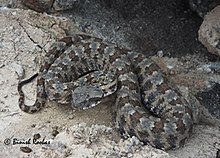
Cerastes cerastes, commonly known as the Saharan horned viper or the desert horned viper, is a venomous species of viper native to the deserts of Northern Africa and parts of the Arabian Peninsula and Levant. It is often easily recognized by the presence of a pair of supraocular "horns", although hornless individuals do occur. Three subspecies have been described.

Field's horned viper is a species of snake in the family Viperidae. The species is native to the deserts of the Middle East. Like all other vipers, it is venomous. It was previously considered a subspecies of the Persian horned viper. The main differences between this species and the Persian horned viper are in scalation and venom composition.

Cerastes is a genus of small, venomous vipers found in the deserts and semi-deserts of northern North Africa eastward through Arabia and Iran. Three species are currently recognized by ITIS, and an additional recently described species is recognized by the Reptile Database. Common names for members the genus include horned vipers, North African desert vipers, and cerastes vipers.

Pseudocerastes is a genus of vipers endemic to the Middle East and Asia. It was originally created as a monotypic genus in 1896 by Boulenger for the species Pseudocerastes persicus, but three species are now recognised: the spider-tailed horned viper ; Persian horned viper and Field's horned viper. Like all other vipers, the members of this genus are venomous.

Vipera ammodytes is a viper species found in southern Europe, mainly northern Italy, the Balkans, and parts of Asia Minor. Like all other vipers, it is venomous. It is reputed to be the most dangerous of the European vipers due to its large size, long fangs and high venom toxicity. The specific name, ammodytes, is derived from the Greek words ammos, meaning "sand", and dutes, meaning "burrower" or "diver", despite its preference for rocky habitats. Five subspecies are currently recognized, including the nominate subspecies described here.
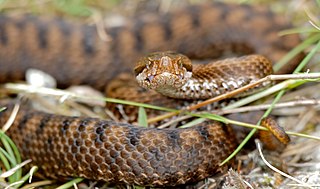
Vipera aspis is a viper species found in southwestern Europe. Its common names include asp, asp viper, European asp, and aspic viper, among others. Like all other vipers, it is venomous. Bites from this species can be more severe than from the European adder, V. berus; not only can they be very painful, but approximately 4% of all untreated bites are fatal. The specific epithet, aspis, is a Greek word that means "viper." Five subspecies are currently recognized, including the nominate subspecies described here.

The many-horned adder is a viper species. It is found in certain rocky desert areas, mostly along the Atlantic coast of southern Africa, in western South Africa and southwestern Namibia. It has characteristic tufts of "horns" above each eye. Like all other vipers, it is venomous. No subspecies are currently recognized.

Cerastes gasperettii, commonly known as the Arabian horned viper, is a venomous viper species found especially in the Arabian Peninsula and north to Israel, Iraq, and Iran. It is very similar in appearance to C. cerastes, but the geographic ranges of these two species do not overlap. No subspecies of C. gasperettii are recognized.

Cerastes vipera, common names Sahara sand viper and Avicenna viper, is a viper species endemic to the deserts of North Africa and the Sinai Peninsula. No subspecies are currently recognized. Like all other vipers, it is venomous.

Montivipera raddei albicornuta is a venomous viper subspecies endemic to Iran. It is a subspecies of Montivipera raddei.
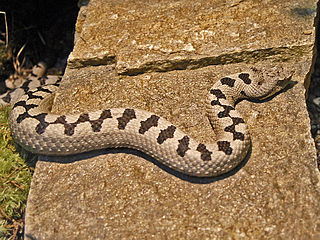
Vipera transcaucasiana is a venomous viper species endemic to parts of Georgia and northern Turkish Anatolia.
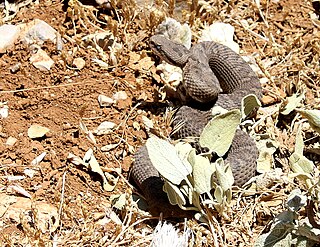
The Lebanon viper, also known as Bornmueller's viper, is a species of venomous snake in the subfamily Viperinae of the family Viperidae. The species is native to Western Asia. There are no recognized subspecies.

The Mount Bulgar viper, also called the Bulgardagh viper is a viper species endemic to the mountains of southern Turkey. Like all other vipers, it is venomous. No subspecies are currently recognized.

Vipera lotievi, commonly known as the Caucasian meadow viper, is a species of venomous snake in the family Viperidae. The species is endemic to Azerbaijan, Georgia, and Russia. There are no subspecies that are recognized as being valid.

Vipera monticola, also known as the Atlas mountain viper, is a viper species endemic to Morocco. Like all other vipers, it is venomous.

Montivipera raddei or Armenian viper is a species of viper, a venomous snake in the subfamily Viperinae of the family Viperidae. The species is endemic to Armenia, Azerbaijan, Iran, Turkey, and possibly also Iraq. Two subspecies are recognized.

Wagner's viper, known as the ocellate mountain viper, ocellated mountain viper, and Wagner's viper, is a species of venomous snake in the subfamily Viperinae of the family Viperidae. The species is native to eastern Turkey and northwestern Iran. There are no subspecies that are recognized as being valid.

Montivipera xanthina, known as the rock viper, coastal viper, Ottoman viper, and by other common names, is a viper species found in northeastern Greece and Turkey, as well as certain islands in the Aegean Sea. Like all other vipers, it is venomous. No subspecies are currently recognized.
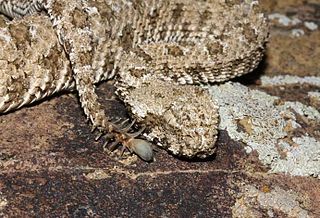
The spider-tailed horned viper is a species of viper, a venomous snake, in the family Viperidae and genus Pseudocerastes. The genus is commonly known as "false-horned vipers".


